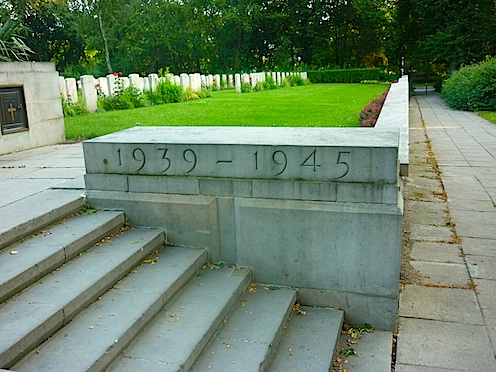On the 1st of November Poles celebrate All Souls’ Day. Here in Poznań, Poland I will go to the Citadel Park and visit the Old Garrison Cemetery. Victims of both World War I and World War II were finally laid to rest there. I will specifically pause at the graves of victims who were killed by the German SS and Gestapo in 1944 after they tried to escape from the Stalag Luft III camp. Stalag Luft III was opened by the German Luftwaffe in 1942. Mainly air force officers of countries such as Britain, the US, Australia and Poland were detained there. The camp was located near the town of Sagan, today as part of Poland Żagań, about 160 km from Berlin. The location was chosen because of the sandy nature of the soil, which would have prevented any effort to escape. The camp and the escape story became famous after the publication of two books: The Wooden Horse (1949) by Eric Williams and The Great Escape (1950) by Paul Brickhill. The American film The Great Escape, with John Sturges as director, which was released in 1963, was based on an adaptation of these two books.
But I will especially turn my attention to the graves of four South Africans. Roger Bushell was born in Springs on 30 August 1910 but emigrated to England at the age of 14. He was the master mind behind the “great escape”. During the spring of 1943 he motivated the group who planned to escape with the following words:
“Everyone here in this room is living on borrowed time. By rights we should all be dead! The only reason that God allowed us this extra ration of life is so we can make life hell for the Hun… In North Compound we are concentrating our efforts on completing and escaping through one master tunnel. No private-enterprise tunnels allowed. Three bloody deep, bloody long tunnels will be dug – Tom, Dick, and Harry. One will succeed!”
The word “Hun” comes from the First World War, referring to a German soldier or officer. So then they built three tunnels to offer 200 men a chance at freedom. Tunnel “Tom” was discovered by the Nazis and “Dick” later served as warehouse for fake identity documents, clothes and for the excess sand.
So “Harry” had to come to the rescue. The tunnel was 102 m long and almost 9 m deep. Wooden planks were used to keep the sand out of the tunnel, a pump was built to breathe fresh air into the tunnel and a rail with a trolley was installed. Tools, ventilation pipes and candle holders were made of the metal containers of Klim powdered milk. (Klim is “milk” spelled backwards; it was provided by the Red Cross.) A considerable amount of negotiation occurred between the “kriegies” and German soldiers and so the refugees could eventually install electric wires with bulbs in Harry. “Kriegies” comes from the German word “Kriegsgefangene” – prisoner of war.
Below is a verse that was found in Leland Potter’s journal while he was in captivity:
It’s in the cards
You may belong to many Clubs,
You may have a big Heart,
You may wear many Diamonds,
But it takes more than a Spade,
To dig out of a Kriegie camp.
On a somewhat moonless night, Friday 24 March 1944, “the great escape” began. A combination of factors caused a delay: during air raids on the camp the electricity was turned off for a while; the escape exit was frozen solid; and Harry did not extend far enough for its opening to be in the dense forest near the camp, which made the situation extremely dangerous. On Saturday morning 25 March at 04:55, the 77th fugitive, Leonard Henry Trent of New Zealand, was detected. The 76 refugees struggled to find the train station’s entrance in the dark. On top of that March 1944 was the coldest March in 30 years, so they had to avoid the snowy forests. In the end only three managed to escape successfully: Per Bergsland and Jens Müller of Norway made it safely into Sweden and the Dutchman Bram van der Stok fled via France to Spain where he found safety at the British consulate.
Hitler ordered that 50 of the refugees had to be killed.
Below is a verse by an anonymous prisoner:
One has gone
We drink to him as comrades must
But it is still the same old story
A coward goes from dust to dust
A gunner from dust to glory.
The remaining prisoners were sent back to their respective camps.
Below is another verse of an anonymous air force soldier who was trapped in a camp (“Uncle Joe” was the name given to Stalin of the Soviet Union):
The Underground Army Air Corps
With our hands on the Klim can
As we dig thru the mire,
We will go eight feet down men,
And then head straight for the wire,
And when the good work is finished
And we leave one hour hence.
You can bet the way is clear men,
From the barracks to the fence.
As I sit in the cooler
Filled with dust, dirt and grime,
Just two weeks to sweat out man,
Bet I’ll escape for sure next time
With no food or zigaretten
The time does move so slowly
So t’hell with the diggin
I’ll just wait for Uncle Joe.
The “cooler” referred to in the poem was a small room in which soldiers were kept in isolation as a form of punishment.
And so I will pause at the graves of the three South Africans who fought on behalf of the South African Air Force. Lieutenant John S. Gouws was born on 13 August 1919. He was arrested at Lindau in Germany and killed at age 24 by Gestapo member Peter Schneider on 29 March 1944. Rupert J. Stevens was born on 21 February 1919. He was arrested in Rosenheim and also killed by Schneider on 24 March 1944, only a little more than a month after his 25th birthday. Both were cremated in Munich.
Lieutenant Clement A.N. McGarr was born on 24 November 1917. He was arrested near Sagan and was seen alive for the last time on 6 April 1944. It is suspected that he was murdered by Gestapo member Lux and was cremated in Breslau.
The funerary urns of 49 of the 50 victims were moved to the Old Garrison Cemetery in Poznań after the war.
For the South African pilots
(Stalag Luft III)
Op vreemde grond agter skokdraad
voor geweerlope en blaffende honed.
Wie het saam met julle oor Suid-Afrika gevlieg?
Maande en maande ondergronds gegrawe
om eindelik weer bogronds te sweef.
Koudmoedig het jul braaf deur herinneringe
opgestyg om tydelik te ontsnap.
Op vreemde grond tydelik op vrye voet
geweerlope en blaffende honde ontsnap.
Waar in Suid-Afrika wou julle land?
Etlike dae en minute op vlug
eindelik tot stilstand voor ’n doodloop.
Koelbloedig het jul braaf opgestyg
en vir ewig tydelikheid ontsnap.
Bibliography: (accessed during October 2016)
http://en.wikipedia.org/wiki/Stalag_Luft_III
http://therealgreatescape.com/




















